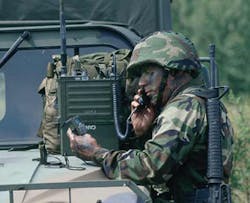Special Ops readies industry competition to develop new manpack radio
MacDILL AIR FORCE BASE, Fla. - U.S. Special Operations Command (SOCOM) at MacDill Air Force Base, Fla., is finalizing plans to buy a next-generation manpack (NGMP) radio in a potential $290 million program.
The NGMP radio will enable Special Operations teams to communicate on selected frequencies from 30 to 2,600 MHz with embedded communications security. It will have an open-systems architecture to enable periodic hardware, firmware, operating software, and radio waveform upgrades. The future Special Operations Next-Generation ManPack (NGMP) Radio will replace SOCOM's current radio communications equipment like the AN/PRC-117F and PRC 117G multiband multimission radios, as well as the AN/PRC-150 multiband radio.
SOCOM radio communications experts are trying to determine if industry can meet their requirements primarily with existing radio technology. The radio - with National Security Agency (NSA) and Joint Interoperability Test Command (JITC) certifications - should be available for purchase no later than 12 months after contract award. The contract will span six years of radio deliveries and could be worth as much as $290 million, SOCOM officials say.
The new radio should be capable of simultaneous two-channel operation with each channel able to support narrowband and wideband waveforms simultaneously while receiving intelligence, surveillance, and reconnaissance (ISR) data in full-motion video as an embedded capability or via an attached mission module.
The NGMP must be able to crossband data from one of its two channels to the other and from the ISR receiver to either of the two radio channels, as well as include an embedded selective availability anti- spoofing module (SAASM) global positioning system (GPS) receiver.
For this radio SOCOM needs Special Forces capabilities like the Demand Assigned Multiple Access (DAMA) integrated waveform (IW) for UHF satellite communications (SATCOM); Mobile User Objective System (MOUS); general-purpose, narrowband and wideband high-frequency (HF) waveforms; advanced special communications modes (ASCM); and electronic counter-counter measures (ECCM) waveforms.
The contractor chosen to provide the new SOCOM radios also must provide program and configuration management, systems engineering to include software, logistics support, operational and depot-level maintenance, data, and training.
Companies interested should e-mail comments, questions, or concerns to NGMP Program Manager David Tenebaum at [email protected] and Leatrice Frederick at [email protected].
More information is online at www.fbo.gov/spg/ODA/USSOCOM/SOAL-KB/H92222-16-R-XXXX/listing.html.

